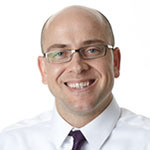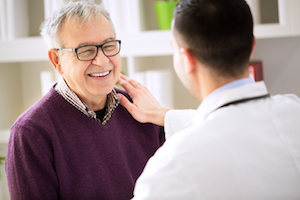Caring for patients in an emergency department (ED) raises a lot of questions for providers. How do patients and families experience our ED? And how do we meet their expectations in this inherently chaotic and unpredictable environment?
In 2015, our ED team at the Redlands Community Hospital was struggling with these questions.
Despite our best efforts, we were meeting our target scores on only 1 of 14 patient satisfaction metrics (as measured by the HCAHPS survey). But even more than ace scores, we wanted to do our best for patients.
So under the leadership of our new Medical Director (Evan), our Advanced Provider Site Lead (Brian) and our ED Director (Pam), we set out to create a true culture of caring in our department.
Believe us, it wasn't easy. But it was worth it.
In today's post, we'll share the story of our patient experience journey, plus some tools and tips for EDs everywhere.
Making Our Roadmap
One of the great things about being part of Vituity is that we never have to go it alone. When it comes to just about every type of quality initiative, there are experts and consultants standing by to help.
Throughout this journey, we received invaluable support from Edward Pillar, DO, and Julia Lyall, RN. Together, they pioneered an innovative inpatient rounding program and have presented their methods at events across the country. Today, they are the enthusiastic force behind Vituity's patient experience initiative.
Ed and Julia jumped at the chance to help us with strategy and planning. Our goal was to create a more relational environment for patients by strengthening our culture of caring. We also wanted to communicate more effectively with our patients and improve efficiency.
Here are some of the processes and tools that Ed and Julia helped us to put into place.
Staff retreat
To create excitement around our new initiative, we hosted a staff retreat for the entire ED. Physicians, advanced providers, nurses, and ancillary staff all attended.
During the retreat, we defined what it means to care for patients "The Redlands Way." What were our values and beliefs around patient experience? How could we live these every day?
Together, we created a shared vision around how to put the care back into healthcare.
Monthly process meetings
One of our priorities was to involve our entire staff — providers, nursing, ancillary staff, and even other departments — in culture change.
To this end, we designated one of our bimonthly operations meetings as an ED Patient Experience Committee meeting.
We used these gatherings to set goals, launch initiatives, and measure success. Rather than trying to change our entire culture at once, we focused on one new process (e.g., care cards) or behavior (e.g., introductions) each month.
Patient experience champion
To help keep everyone on track and accountable, we appointed a team member (Brian) to champion our patient experience efforts.
Brian's leadership sends the message that caring isn't just the Medical Director's job, it's everyone's job. Also, appointing a champion puts patient experience on the same footing as clinical initiatives like stroke and sepsis.
Provider-driven patient callbacks
According to the American College of Emergency Physicians, patients who receive a follow-up phone call rate their ED satisfaction 30 to 70 percentile points higher than those who did not receive such a call.
We knew that calling our discharged patients was one of the best ways to show genuine care and concern. So we set individual and department goals for callbacks and created a transparent tracking process in which everyone's stats are visible to the team.
To further encourage participation, we offered a $10 bonus payment per call (though we set the expectation that this amount would diminish over time).
We encouraged providers to call back three kinds of patients in particular:
- Those about whom we had ongoing concerns (e.g., due to a complex conditions or lack of social support)
- Satisfied patients who could provide positive feedback
- Less satisfied patients who might present an opportunity for service recovery
Care cards
Communication cards are given to every patient in order to enhance communication with providers and staff. They show the patient who's on their care team, what tests and procedures have been ordered, and the expected wait times. There's also a handy discharge checklist and space for patients to leave feedback.
Collaborative learning
A few months into our patient experience initiative, we had the fortunate opportunity to participate in Vituity's yearlong Patient Experience Collaborative. (A healthcare collaborative is a shared learning experience aimed at driving rapid quality improvement.)
To kick off the program, medical and nursing directors from the six participating EDs met with Ed, Julia, and the collaborative faculty to explore tools and best practices and create improvement plans.
We then received monthly coaching calls with the collaborative faculty to help us put our plan in motion.
So how did it go?
We began our patient experience journey in early 2016. Within just a few months, we saw vast improvement in our HCAHPS scores. By October, we had met or exceeded our targets in 12 of 14 categories.
Our callback program was one of our biggest triumphs. Some statistics to date:
- 100 percent of our full-time physicians and advanced providers meet their callback goals.
- Each provider calls at least two patients per shift. That's about 60 patients a month per provider.
- 25 percent of our patients receive calls. That's 1,000 patients per month.
Many of our favorite successes come in the form of stories rather than statistics. Our hospital CEO has received multiple complimentary letters from patients praising their ED care. But it's a thrill when we experience that gratitude firsthand.
- One patient we called back was so moved to hear from us that she wrote a heartfelt story about it on a community Facebook page. She has since attended both our local patient experience retreat and Vituity's annual conference to speak on the subject of patient experience.
- We also received a letter from a woman who'd been diagnosed with a lung mass in our ED. When one of our nurse practitioners called her back, she was having trouble getting doctor's appointments. The NP made a few calls and scheduled the patient for the follow-up she needed. As it turns out, the patient was diagnosed with a treatable but fast-growing cancer. In her letter, she thanked the NP for saving her life.
In addition, we've noticed a significant increase in the morale and job satisfaction experienced by ED providers, nurses, and staff.
A few months into the callback program, we surveyed our providers about their motivations. Was the $10 payment the reason they were complying?
To our surprise, the vast majority of respondents said no. They were far more motivated by the positive responses the callbacks elicited from patients.
Overall, we've found that when patients react positively and thank us, it has a synergistic effect on our culture. We're inspired to keep the patient experience in the forefront of our care.
Lessons learned
It's been almost two years since we started our patient experience journey, but the learning has never ended. Here are the elements that we credit with our success.
- Start with creating buy-in and a sense of mission. Our staff retreat was invaluable in helping us to create a shared vision for our department.
- Recurring behavioral patterns (such as those created by performing callbacks and holding regular committee meetings) are important in increasing mindfulness around the patient-provider relationship that drives culture and maintains program momentum.
- Culture change requires a multidisciplinary approach. Change efforts should involve medicine, nursing, and staff from all departments who care for ED patients. (We have benefited from the support of radiology, respiratory therapy, and many other areas of the hospital.)
Ultimately, we set out to create a more patient-centered environment and improve communication and efficiency. But in providing better care for patients, we realized that we were also better caring for one another.
We thank our mentors and colleagues for their support and hope to continue living out what it means to care for people "The Redlands Way."

























